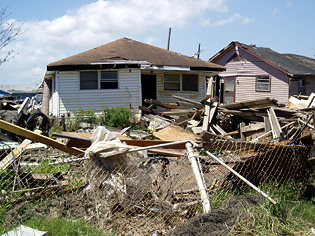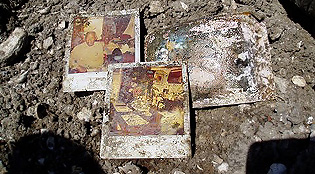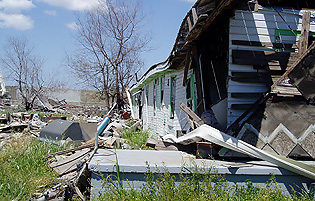
Nicola Stewart
Nicola Stewart got to ring the bell seven times.
It wasn't just any bell. For each toll signified that a person listed as missing after Hurricane Katrina or Rita had been found alive and his or her family notified.
In April 2006, Stewart, a genetic counselor from the
UCSF Cancer Risk Program, spent a week in Baton Rouge, LA, as part of a visiting working group of genetic counselors from around the country who were tapped to assist staff at the Louisiana Family Assistance Center. The center was created to reunite missing people with their families and to help family members locate their deceased loved ones.
Since the hurricanes hit in August, almost 12,000 individuals have been reported missing. As of mid-June of this year, 10,686 people have been found alive and 860 confirmed as victims; 163 are still missing. This number changes daily, as a small brass bell that hangs on a wall in the center's office is rung triumphantly, sometimes up to five times an hour, by staff.
"Everyone takes personal satisfaction whenever the bell is rung, signifying another person found alive," said Louis Cataldie, MD, Louisiana state medical examiner. "Everyone at the center stops working and claps when they hear that bell. It's this success that keeps us working to reunite families with missing loved ones."
 |
|
Flood Ravages
After the hurricanes struck, there were thousands of people reported missing. State officials were faced with the daunting tasks of identifying remains - often bodies, sometimes parts of bodies, left unidentifiable by the ravages of the flood - and of locating individuals reported as missing.
"Many people survived Hurricane Katrina, but it was the flooding that created the most damage and death," said Stewart. "Bodies sat in water for weeks and weeks before they were found, making them difficult to identify by conventional means such as appearance, dental records or even identification that might be found in pockets."
According to Stewart, DNA identification is often a last resort, and is most successful when a direct DNA match is made by comparing a sample from the victim and from the victim's personal items, such as a toothbrush or hairbrush.
"In New Orleans, everything that could have been used to make a direct DNA match was destroyed, so DNA identification through family members was necessary," Stewart said.
The more closely related two individuals are, the more similar their genetic profiles are. To compare family members' DNA, the exact relationship needs to be understood, and genetic counselors could bring this to the table. "For example, the amount of DNA shared among full siblings, half-siblings and step-siblings is very different, and this information is critical for making an accurate identification," said Stewart.
Experience with Emotional Crisis
The work Stewart and her colleagues do for the Cancer Risk Program combines diligence with meticulousness in determining exact relationships. In assisting families with a history of cancer, genetic counselors assess the personal and family history, provide education and counseling, and when appropriate, will offer genetic testing for cancer predisposition genes. They also provide psychological support.
"My experience in dealing with families going through emotional crises also proved valuable. I spoke with a man who had relocated to North Carolina. He had literally lost everything after living his whole life in New Orleans," said Stewart. "Much like the people with cancer who need to tell their story, these people needed to tell their story in order to heal and make meaning of the crisis."
One of Stewart's roles was to establish family trees for missing persons, with the ultimate goal of locating the individual and contacting families. "I was tasked with calling existing phone numbers, searching the Internet and even trying to find out if a person may have applied for a driver's license," said Stewart.
 |
|
She was also tasked with trying to locate family members and determine which relative would be the best match for providing a DNA sample to compare with the unidentified remains.
"We would try to find out how many children, adult children, parents, siblings - anyone who might be able to provide DNA samples," she said.
Overall, there were some challenges. Because helpful information in the form of postal forwarding addresses and credit card data is not generally accessible due to privacy laws, workers could not take this route. Information that could be obtained, however, was passed on to the geneticists to take the next step.
Shock in the Ninth Ward
Born in Ireland and raised in North Carolina, Stewart is familiar with the aftereffects of a hurricane, but was not prepared for what she saw when she and her colleagues toured the Lower Ninth Ward, site of the worst damage inflicted by Katrina.
"Once I saw the destruction, it reframed what I was doing for these families," she said. "Vibrant neighborhoods were now left in ruins. Where there were once houses and families, there were now driveways leading to bare foundations."
In talking to family members, Stewart was told by many that they themselves wanted to return to New Orleans one day. Some felt that they were getting great opportunities where they were, but that it wasn't home, a place where families lived in the same house generation after generation.
"They truly feel like a fish out of water," she said.
Like many when the hurricane first hit, Stewart watched the news on television, and read news stories in the paper and on the Internet.
 |
|
"Not until you see the damage firsthand do you realize the enormity of the devastation," Stewart remarked. "And after working with families, there was a tendency to develop an attachment to the person I was trying to help locate. You definitely get a sense of what the family has gone through."
The Louisiana Family Assistance Center also helps families locate family members who were victims of the hurricane. In some cases, the center has helped with funeral arrangements, and has provided emotional and spiritual support. In other cases, the center has relied on assistance from forensic anthropologists and dentists, along with genetic counselors and geneticists.
"Finding people alive and reuniting those with family members became a nice balance to some of the other cases, which did not always have a happy outcome. Inevitably, sometimes it was enough to bring closure for the family," said Stewart.
The work will continue at the Louisiana Family Assistance Center until every person identified as missing has been accounted for or found. In January, more than 2,000 people were still listed as missing. When Stewart arrived for her assignment in April, there were 990 people listed as missing. That number has continued to decrease substantially.
While the work to expedite identification of missing persons has shown significant progress, according to Stewart, work to restore New Orleans has been less promising.
"When I was first offered a chance to participate, I assumed that New Orleans was in the process of rebuilding," she said. "Many people have expressed that they feel the rest of the world has moved on from Katrina, but New Orleans is still dealing with the aftermath. They can't rebuild until they clean up, and there's only so many trucks available to clear the mass of debris."
Despite the reality that the area still faces, Stewart is thankful for the experience. "This was some of the most rewarding work I have ever done, and I'm grateful to the staff of the Cancer Risk Program and UCSF for allowing me to participate," Stewart said.
Photos by Nicola Stewart.



